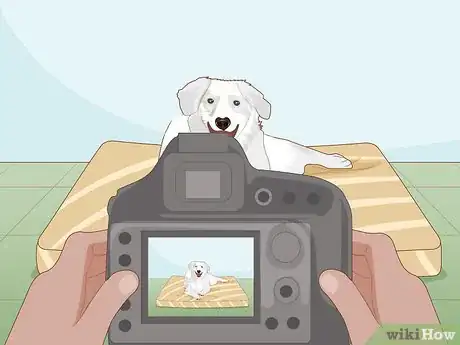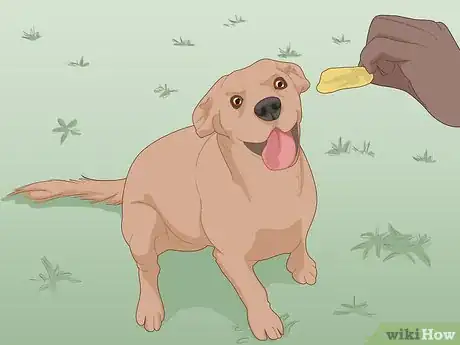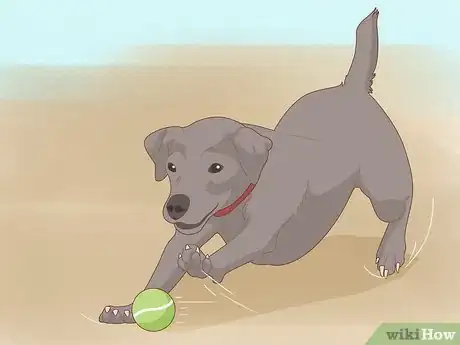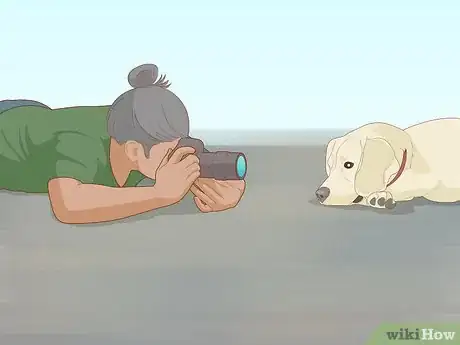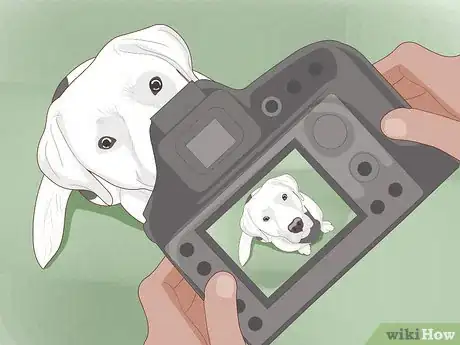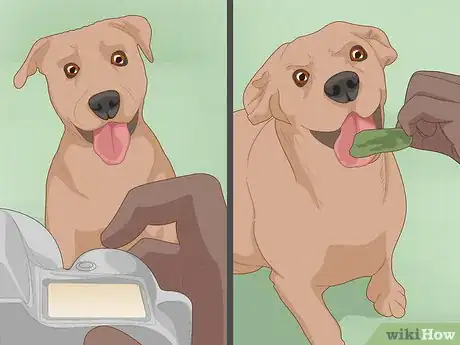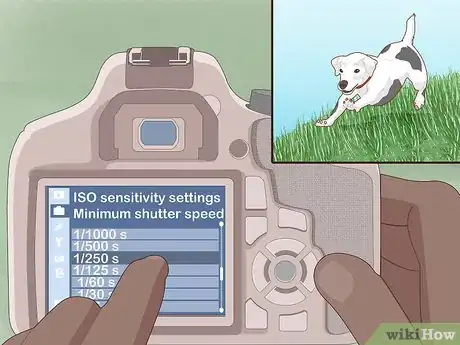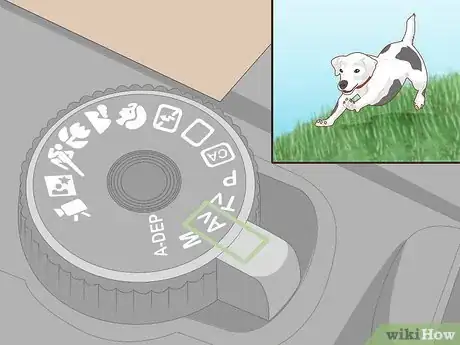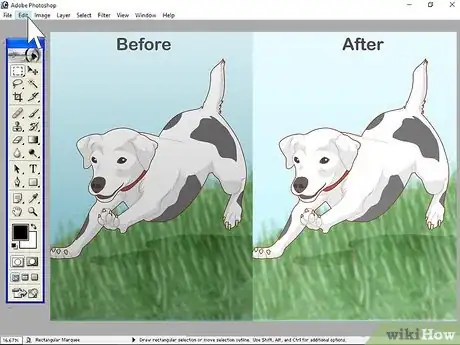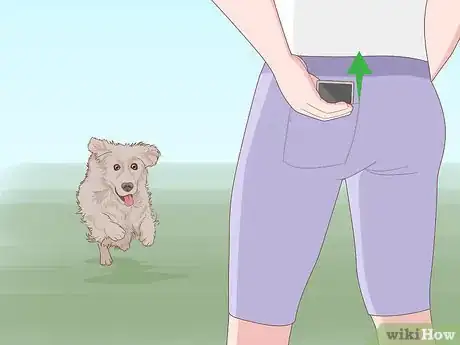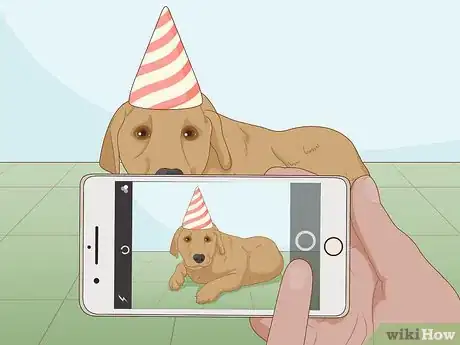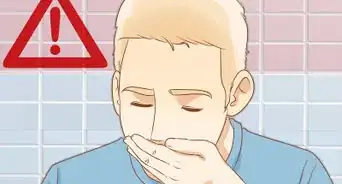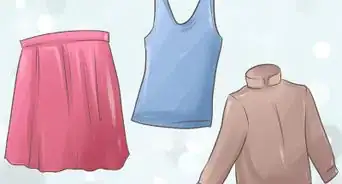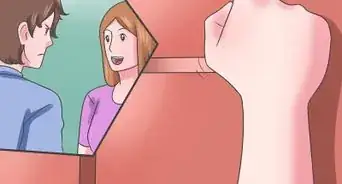This article was co-authored by Coryn Kiefer Helmken. Coryn Kiefer Helmken is a Professional Photographer and the Owner of Coryn Kiefer Photography in Albuquerque, New Mexico. Coryn specializes in fine art portrait and wedding photography. She holds a BA in English and Visual Arts from Union College. Coryn’s photography style is timeless, romantic, and clean.
There are 8 references cited in this article, which can be found at the bottom of the page.
This article has been viewed 25,744 times.
Most people love taking pictures of their pets, but getting your dog to do just the right thing at the right time can be tricky. They might not look at the right place or they may not sit still enough for the camera to capture them. Fortunately, there are several things you can do to improve your chances of getting a great shot of your dog. Take steps to set up the ideal photoshoot, and change the settings on your digital camera so that they are optimal for shooting pets. For more candid, everyday shots, use your smartphone so that you don’t miss a moment.
Steps
Taking the Pictures
-
1Find the right setting. Many pet photographers feel that the best place to photograph a dog is outdoors because this is a very natural environment for the dog.[1] However, you can also think about your dog’s personality when figuring out where to take the photos. For example, if your dog really loves his bed, then try taking a few photos there. Try to think of the place that your dog seems the happiest, and use that as your setting.
- Don’t forget to try out a few different locations. For example, take a few pictures in your dog’s favorite indoor location, but try taking some outside too.
-
2Get your dog’s attention. If you are taking still shots and you want the dog to look at the camera, then have the dog sit in the desired position. Once your dog is still, get him to look at you by calling his name or showing him a treat.[2]
- If you have someone to help you, have them hold the treat where you want the dog to look. Use a happy tone of voice when you talk to the dog so that your dog will look happy and excited in the photo.
- If you want the dog to look at the lens, you can use a treat or a squeaky toy and hold it with one hand next to the lens. If you use a squeaky toy, squeeze it a few times to get the dog to look at you.
-
3Try to anticipate your dog’s movements. When taking action shots, it can be tricky to get your dog at just the right moment. Spend some time observing how your dog moves before trying to catch the perfect photo. This way you’ll be able to better anticipate your dog’s next move.[3]
- For example, does your dog tend to run in short, quick bursts, or does he jog along slowly? Do they make a particular facial expression when they’re about to try to catch something? Do they make a noise before they take off running? All of these will help you anticipate your dog’s next move more easily.
-
4Get low to the ground. You can take some pictures looking down at your dog, but this is the normal human perspective. To make your photos interesting, try getting down on your knees or on your stomach and getting a dog’s eye view of the world.[4]
- You can also take pictures from various heights. Take some pictures sitting on your knees, and take some pictures while you’re laying on your stomach. You can even take some pictures lying on your back with your dog looking down into the lens.
- Try to focus on your dog's eyes—sometimes the camera will focus on the fur, so the eyes won't stand out as much in the picture.[5]
-
5Limit photo sessions to half an hour. If you want a portrait shot of your dog, then start your photoshoot with the still shots. After you’ve taken several shots of your dog sitting still, move on to action shots. Don’t force your dog to sit still for hours. This will not be fun for the animal. Instead, start your sessions with a few still shots and then let your dog play while you capture action shots.[6]
- Don’t be afraid to run around and play with your dog, snapping shots when you can. This will keep it fun for both of you, and you’re more likely to catch a shot of your dog looking happy.
- If your dog isn’t cooperating, don’t try to force the situation. This will leave both of you feeling frustrated. Instead, give up for the day, and try again tomorrow. Don’t punish your dog. Taking photos isn’t something that he understands naturally.
-
6Try different angles. Getting low to the ground can help you capture great photos of your dog, but don’t be afraid to be creative. Try taking pictures of your dog from several different angles. You might capture a really great photo of your dog by doing this.[7]
- For example, stand behind the dog and take his picture from behind. Take a picture with the lens pointing directly down at your dog’s face. Try lying down on the ground and take a picture looking up. You could even try turning the camera upside down and take a picture that way.
-
7Reward the dog. If you are taking still shots and your dog is following a lot of commands (e.g. sitting still, looking directly at the lens, etc.) don’t forget to reward your dog with a treat. This will help your dog understand that he is doing the right thing, and photo sessions are a positive thing.[8]
Adjusting the Settings on Your Digital Camera
-
1Choose Al Servo mode. Sometimes it can be hard to catch your dog sitting still. Unless you are taking photos where your dog is sitting still, you will probably want to use Al Servo mode on your digital camera. This mode causes your camera to lock onto the subject, but keeps refocusing so that moving shots won’t come out blurry.[9]
- If you are photographing your dog when he is sitting still or when using flash, you should use One-Shot mode.
-
2Set your shutter speed. If you are trying to catch your dog in a quick movement, such as in the middle of a jump, you’ll probably want to set your shutter speed to at least 1/250. This will keep the image crisp, and you can capture your dog doing something really cool.[10]
- Slower shutter speeds may make it difficult to catch your dog in the middle of an action.
- Keep in mind that a faster shutter speed will not work well in low light conditions. If you want to take action shots, try to have your photo session on a nice sunny day.
- You can also use continuous shot mode, so when you press the shutter button down on your camera, it will take several photos in a row.[11]
-
3Choose the exposure level. Most photographers recommend choosing aperture priority mode when trying to photograph pets. This will bring your pet into sharp focus and the less important aspects of the photo (e.g. the tree in the background) will be less focused.[12]
- On the other hand, if the background is important for the photo, you can always turn aperture priority mode off so that the camera will keep everything in focus.
-
4Don’t forget that you can edit your photos. You might get a really great shot that is just a bit too dark or that has just one small flaw. Most professional photographers edit their photos using software such as Adobe Photoshop. If you’re not too familiar with all of the settings of your digital camera, you can always set it to Auto and then use an editor to make the photo just right.[13]
- Be aware, though, that if you set your camera to auto your shutter speed will probably be too slow to catch any action shots. Auto will probably work great in good lighting for portrait shots, but not so well if you’re trying to catch good shots of your dog playing.
Taking Pictures With a Smartphone
-
1Have your phone ready to go. You may see a great photo opportunity, but miss it because you couldn’t get your phone out fast enough to catch it. If you are able to keep your phone ready, you’ll be sure to catch any great shots of your dog.[14]
- For example, try keeping your phone in your back pocket or in your hand with the camera application open.
- Obviously, it wouldn’t be practical to do this all of the time, but if you’re out playing with your dog or if your dog is in a particularly playful and happy mood, then keep your camera handy.
-
2Keep it simple. When you are using a digital camera, you can do lots of interesting things like zooming in on a specific part of your dog, such as the nose or eyes. Unfortunately, with a smartphone, those tricks don’t work as well. You can still get great photos, but try to keep your photographs simple and straight forward.[15]
- If you want to take a close-up of your dog, get close enough so that you can see your dog’s eyes and facial expression clearly, but don’t try to focus in on a specific feature.
-
3Take photos at the right time of the day. With a professional camera, it is easier to work with different types of lighting, but you don’t have the same control with a smartphone camera. Try to take the photos so that your dog faces into the sun; this way that will be bright and easily visible. If it is very sunny, try taking the picture in the shade so that your dog isn’t washed out.[16]
- The best time of day to take photos with a smartphone is in the morning and late afternoon/early evening. During this time, the sunlight won’t be too harsh.
Expert Q&A
-
QuestionWhy don't my dog's eyes show up in pictures?
 Coryn Kiefer HelmkenCoryn Kiefer Helmken is a Professional Photographer and the Owner of Coryn Kiefer Photography in Albuquerque, New Mexico. Coryn specializes in fine art portrait and wedding photography. She holds a BA in English and Visual Arts from Union College. Coryn’s photography style is timeless, romantic, and clean.
Coryn Kiefer HelmkenCoryn Kiefer Helmken is a Professional Photographer and the Owner of Coryn Kiefer Photography in Albuquerque, New Mexico. Coryn specializes in fine art portrait and wedding photography. She holds a BA in English and Visual Arts from Union College. Coryn’s photography style is timeless, romantic, and clean.
Professional Photographer A lot of times the camera will focus on the fur, which can make the eyes not show up. To avoid that, make sure to focus right on the eyes.
A lot of times the camera will focus on the fur, which can make the eyes not show up. To avoid that, make sure to focus right on the eyes.
Warnings
- Don’t scold your dog during your photo sessions. If your dog is scared or feels that he is in trouble, he probably won’t look happy and alert in the photos.⧼thumbs_response⧽
- Avoid taking your dog to a place where he might feel scared or threatened while you are taking photos. A frightened dog may run away or become aggressive.⧼thumbs_response⧽
References
- ↑ http://www.popphoto.com/how-to/2015/01/tips-pro-gary-parkers-dog-photography
- ↑ http://www.popphoto.com/how-to/2015/01/tips-pro-gary-parkers-dog-photography
- ↑ http://www.mnn.com/family/pets/stories/how-to-photograph-dogs-in-action
- ↑ http://www.mnn.com/family/pets/stories/how-to-photograph-dogs-in-action
- ↑ Coryn Kiefer Helmken. Professional Photographer. Expert Interview. 19 February 2021.
- ↑ http://www.designsponge.com/2014/03/10-tips-for-photographing-your-dog-from-rachael-hale.html
- ↑ http://barkpost.com/13-tips-for-taking-the-greatest-pics-of-your-dog/
- ↑ http://time.com/4068662/10-tips-to-photograph-your-dog/
- ↑ http://www.mnn.com/family/pets/stories/how-to-photograph-dogs-in-action
- ↑ http://www.mnn.com/family/pets/stories/how-to-photograph-dogs-in-action
- ↑ Coryn Kiefer Helmken. Professional Photographer. Expert Interview. 19 February 2021.
- ↑ http://www.digital-photo-secrets.com/tip/1330/which-mode-is-better-aperture-priority-or-shutter-priority/
- ↑ http://barkpost.com/13-tips-for-taking-the-greatest-pics-of-your-dog/
- ↑ http://www.designsponge.com/2014/03/10-tips-for-photographing-your-dog-from-rachael-hale.html
- ↑ http://tailblazerspets.com/blog/2015/02/5-tips-for-taking-better-pet-photos-with-your-smartphone/
- ↑ http://tailblazerspets.com/blog/2015/02/5-tips-for-taking-better-pet-photos-with-your-smartphone/
